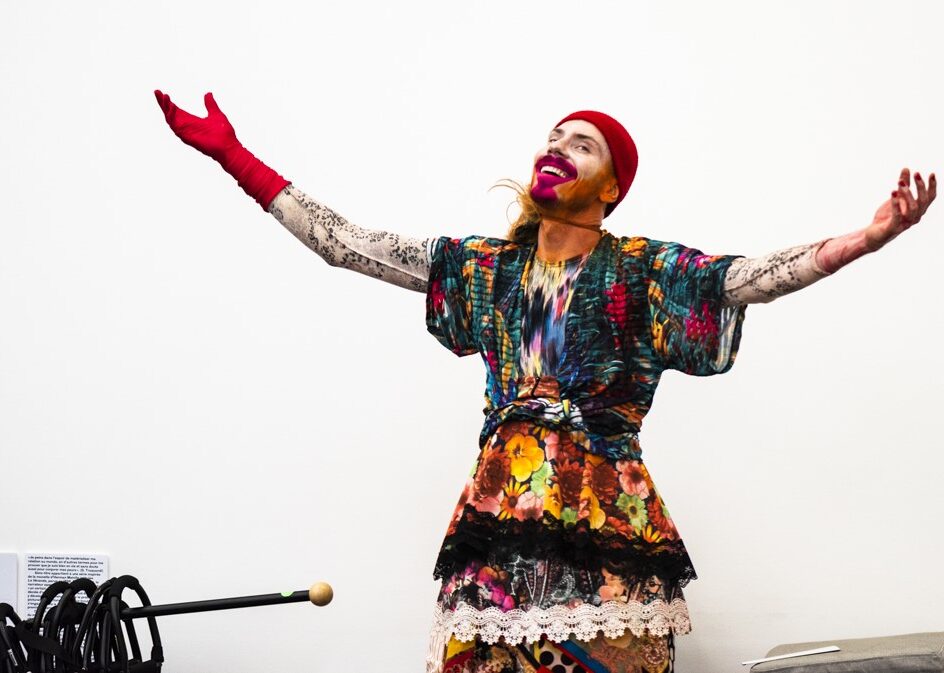
Volmir Cordeiro & La Ribot: Words do Something Else, They Shape the Direction of a Piece
What if words were the key to working? The Brazilian choreographer Volmir Cordeiro, who lives in Paris, begins a wide-ranging conversation with the Madrid-born dancer, choreographer, filmmaker and visual artist La Ribot, currently based in Geneva – where she teaches at HEAD (Haute école des beaux-arts et de design) – on creation, including decision-making and freedom in work, as well as relationships with others… Shaping ideas – what is that?
Volmir Cordeiro talks to La Ribot. We introduce the excerpt of their interview, which was published in WATT – contemporary dance magazine – in 2017 and which can guide you in the process of their thinking. A Skype interview which took place in August 2016.
Volmir Cordeiro: I laid out several issues to bring up with you. From there we can develop what interests us today – this conversation today. I record and transcribe it, and I give the transcription to Charlotte. For my thesis, I do interviews with dancers and I transcribe them myself – it’s fascinating. It has to do with memory, or what we think we remember of the discussion. When I am transcribing, I pick a direction, creating a certain distance – it’s quite different from reading the interview itself. Transcribing is not the same as writing, either.
La Ribot: When I do this sort of interview exercise, I speak really poorly. Then, when the person sends me the text, I say to myself – it isn’t possible! And I start the real work, saying: “This is what I wanted to say.” And the work becomes super interesting – and also huge. I realize that language – meaning the threads of living thought – has nothing to do with the thinking involved in reflection and in writing. And there I have another big problem: what do we want? The live interviews where you can’t understand what they’re saying, or the rewritten, more reflective ones? I always prefer the second option.
Volmir Cordeiro: At the same time, it’s also good to see what happens in these more spontaneous moments – less controlled – where the words flow out without needing to appear intelligent or say weighty things.
La Ribot: We could do both – with questions in blue answered live, and then the ones in red corrected by afterthought. The last time I did an interview, I was completely incomprehensible – but still quite touching.
Volmir Cordeiro: I like that there can be shadow zones – situations in which meanings are less defined. In any case, we won’t publish any of this unless both of us agree on what is and was said. So there will be a period for revising. But it can all be re-transcribed like the beginning of the interview – examining the structure itself. What it is which makes an interview for us, what does it mean for us to be interviewed – let’s look at the words. What do they say about us? What do we want them to say about us? How do we get into this work?
La Ribot: Yes – I just bought a 200-page book, an interview of an artist I adore, and it’s just great to read.
Volmir Cordeiro: Who is the artist?
La Ribot: John Armleder – a Swiss artist I like very much. It’s a single interview he did with a critic, and it runs throughout the book.
Volmir Cordeiro: I think they should publish more interviews between artists – especially dancers – because we talk a lot when we are working, but the words remain hidden or are forgotten. There is no presentation or concrete existence for them.
La Ribot: There are so many things we say when we are working on the staging, the choreography, the back and forth between all the collaborators – be they the dancers or the lighting designer – it is an essential part of the process. We never really talk about directing – the staging. We never really mention the fact that in order to get something up on that stage you have to share, to talk – saying “yes”, “no”, fighting for it, looking for ideas, removing something, cleaning, dropping it, doubting, not sleeping!
Volmir Cordeiro: These are things we don’t generally have access to.
La Ribot: It’s too bad – because they could shine a light on parts of our practice.
Volmir Cordeiro: In the work – its construction – at the beginning, middle, or end of the project, have you established a special place or designation for words? How do they manifest? Is it just a way of finding perspective on what has already been done – an introductory moment to share a perspective on the project – or is there a specific targeted structure in your process which includes the use of words?
La Ribot: For me it is necessary – it all depends on the people with whom I am working – for me to speak more or less, introducing or setting things up, during it explaining or just experiencing pleasure. For example, for my most recent creation Another distinguée (2016), I invited Juan Loriente – someone I have known for twenty-five years. We get along and appreciate each other. So he shows up, I start talking, and ten minutes later we are improvising without having to say anything more – for an entire week.
You can find more in WATT #1
Link to order WATT #1 : http://w-a-t-t.eu/?p=116
Link to order WATT #2 : http://w-a-t-t.eu/?p=118